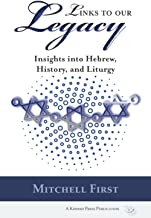Links to Our Legacy: Insights into Hebrew, History, and Liturgy, Mitchell First, Kodesh Press, New York, NY, ©2021, ISBN 978-1-947857-66-7, p. 232, plus appendices, $19.95.
By Fred Reiss, Ed.D.

 WINCHESTER, California – Tanakh, the all-inclusive Hebrew word for the Bible—Torah, Prophets, and Writings—holds many problems and puzzles: What does an infrequently used biblical Hebrew word actually mean? Does the Bible describe true historical fact, or just fantasy? What is the origin of particular prayers? Attorney and independent biblical researcher Mitchell First, in his newest book Links to Our Legacy, continues his mission to find lost meanings and correct inaccurate historical accountings.
WINCHESTER, California – Tanakh, the all-inclusive Hebrew word for the Bible—Torah, Prophets, and Writings—holds many problems and puzzles: What does an infrequently used biblical Hebrew word actually mean? Does the Bible describe true historical fact, or just fantasy? What is the origin of particular prayers? Attorney and independent biblical researcher Mitchell First, in his newest book Links to Our Legacy, continues his mission to find lost meanings and correct inaccurate historical accountings.
First divides Links to Our Legacy into three parts. In the opening section, called “Hebrew Roots,” which holds thirty-four chapters, he investigates biblical challenges posed by the roots of Hebrew words. For example, Psalm 22 opens with “la-menatzeaḥ al ayelet ha-shaḥar mizmor le-David,” meaning “For the leader, a doe of the dawn, a psalm of David.” By asking what is “a doe of the dawn,” he looks into and weighs other biblical and rabbinic uses of and references to the word ayel (doe). One such use is “strength” in Psalm 88, implying a reasonable translation in Psalm 22 is “strength of the morning,” that is sunrise, or perhaps, as the Talmud suggests, the two horns of morning’s first light. First rejects this—a doe does not have horns. Maybe it’s the morning star…. no, a star is a dot in the sky, not a doe. Perhaps a musical instrument; again, no. There are no instruments resembling a doe. Rashi thinks the doe is a metaphor for the children of Israel. First sides with Soncino’s explanation; “a doe of the dawn” is a now long-forgotten song and Psalm 22 is sung to its melody.
In part two, entitled “History,” First explores and analyzes twenty-five historical questions, including: “Invention of the Alphabet” and “Why was Moses Commanded to Remove His Shoes at the Burning Bush?” Chapter 13 in this section, “The Earliest Surviving Texts of the Torah,” tells the fascinating stories of who owns and what happened to the earliest surviving Torah scrolls, including: The Leningrad Codex from the 11th century now housed in St. Petersburg; the destruction of the Aleppo Codex mostly burned during the Aleppo, Syria riots, occurring in December 1947, soon after the UN voted to partition Palestine, and whose remains were later smuggled to Israel; Codex Or. 445, an early 9th century copy of the Pentateuch, now housed in the British Museum. Going back even further, First describes the history of the collection of texts comprising the Dead Sea Scrolls and other fragments, such as the burnt remains of a 4th century Torah found in Ein Gedi, the 8th century Torah texts known as the London and Askhar-Gilson 2 Sheets, and the story behind the Codex Sinaiticus discovered in St. Catherine’s Monastery located in the Sinai Desert.
“Liturgy,” the third part, has seven chapters. Here, First examines words found in some Jewish prayers and describes competing historical theories surrounding others. He also looks into the historical context of whole prayers, such as the Alenu, as well as the reasoning behind the annual recitation of the five megillot (Song of Songs, the Book of Ruth, Book of Lamentations, Book of Esther, and Ecclesiastes).
One need not be a Hebrew grammarian, lexicographer, or even a wordsmith to appreciate the biblical mysteries, and the arguments and conclusions offered by First. It seems to me, however, that those having a solid acquaintance with the Hebrew alphabet, the Bible, and prayerbook “geography” will benefit most.
*
Fred Reiss, Ed.D. is a retired public and Hebrew school teacher and administrator. His newest book is The Jewish Calendar: History and Inner Workings, Fourth Edition. He may be contacted via fred.reiss@sdjewishworld.com.
Pingback: Book Review: Links to Our Legacy by Fred Reiss | Kodesh Press